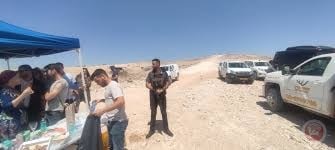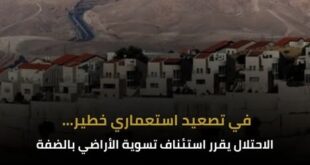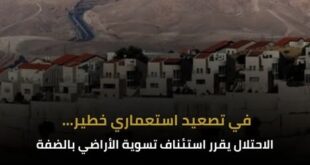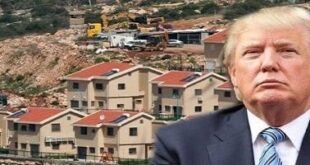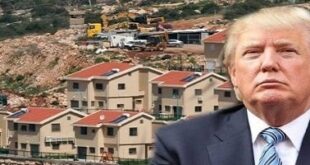By: Madeeha Al-A’raj
The National Bureau for Defending the Land and Resisting Settlements stated in its latest weekly report , that the Israeli policy of demolishing Palestinian houses and facilities is an old one that began in 1948 i.e. since the establishment of the Israeli State, as it destroyed more than 500 Palestinian villages and towns of what’s known as the Nakba. The number of homes demolished at that time was about 170,000, resulting in the displacement of about 1,000,000 Palestinians. Israel continues to practice the same policy in the Palestinian territories that it occupied in 1967, and adopts many justifications for that, the most prominent of which are, ‘demolishing facilities under the pretext of not having a building license permit in areas C, under the pretext of Israeli security needs, or the presence of the facility in military areas, or as collective punishment in the event of carrying out operations that lead to the killing of Israelis.
The occupation authorities rely on the Emergency Law, which was used by the British Mandate authorities in Palestine in 1945, and remained in effect even after the establishment of the State of Israel, which continues to use it against the Palestinians under various security pretexts. They base this policy on Article 119 of the British Emergency Law of 1945, which states that the demolition of houses is an administrative measure applied without trial, although this is in conflict with Article 64 of the Geneva 4th Convention.
The latest development for the Israeli demolition’s policy is the Israeli government’s decision on June 28, 2024, to withdraw the powers of the Palestinian National Authority in more than one area, especially in the Jerusalem desert ‘which is in Area B’, and to initiate procedures to demolish Palestinian construction there. According to the Oslo Accords, the powers of enforcement, construction, planning, and everything related to the administrative affairs of the residents in Area B are within the powers of the Palestinian Authority. However, the situation has changed, as if the withdrawal of powers from the Palestinian Authority indicates a gradual restoration of Israeli powers over areas that were transferred to the Palestinian side within the context of the agreements.
In this report, we focus on two examples of the Israeli demolition policy in the Bethlehem and Salfeet Governorates, for example but not limited to. In this regard, the talk these days is about the village of Al-Malha, east of the town of Za’tara in the Bethlehem Governorate that has an area of about 14,000 dunams, which is in great danger after the Civil Administration crews continuously carried out surveying and planning work among citizens’ homes and on their lands after the Israeli government’s decision referred to above, and in light of the escalating pressure from official institutions and Israeli settlement associations, especially the ‘Regavim settlement organization\, since Minister Smotrich announced the imposition of civil and administrative control over an area extending between Beit Sahour and the Jordan River, east of Jerusalem, estimated to be about 85 km long and 25 km wide.
According to a report published by the organization years ago, the Palestinian Authority has begun building scattered homes and buildings in the Jerusalem desert. It claims that this construction comes as part of a Palestinian plan to expand Palestinian construction in the West Bank and create a new reality.Regavim, which prepared this report, is a right-wing settler organization founded by Bezalel Smotrich and Yehuda Eliyahu, an extremist settler who became the director of the settlement department in the Civil Administration under Minister Smotrich. It works to combat Palestinian construction, Judaize the West Bank, and end the Oslo Accords. Since 2018, many of its cadres have held important positions in the occupying state and have become decision-makers in everything related to settlement and the future of the West Bank.
` Head of the Malha village council, Murad Jadal, recently explained the picture in an interview with ‘Ultra Palestine’ that a year and a half ago, the establishment of a model village and infrastructure began in this area, and a village council was built for it under the name of the Malha Village Council. These steps didn’t please the occupation settlement associations, and since then the harassment began, every week settlers, delegations, Knesset members and ministers come to the village, the last of whom was 10 days ago when Avigdor Lieberman, head of the ‘Israel Beiteinu party’ stormed it, and immediately after him Smotrich, and made promises to remove the infrastructure and buildings from it.
Within the context, the head of the village council explained that over the years, the areas available for construction in Bethlehem have become limited, which has led to urban expansion reaching those areas that are owned by Palestinians. However, the ‘Regavim organization’, which monitors ‘illegal’ Palestinian construction, as it describes it, was submitting reports on construction activities in Area C and in this area in particular. Despite this, there were no serious prosecutions of Palestinians during that period. With the current right-wing government taking office and granting Smotrich powers in the Civil Administration and appointing a deputy who is basically a member of the organization, responsible for monitoring so-called illegal construction, these reports began to receive a response.
The Israeli authorities began to pursue Palestinians in these areas, as this settlement organization prepared a random map showing the presence of 3,000 homes and facilities in this area that were described as being built illegally, and it is expected that a campaign will begin to remove them. The targeted area is between 170 and 180 square kilometers, extending from the Jerusalem wilderness to parts of Hebron. Finance Minister and Minister of Settlement in the Ministry of Defense, Bezalel Smotrich, stormed the village of Malha last Sunday and claimed that the Palestinian Authority is trying to control the eastern areas “to cut off Israel’s geographical continuity,” as he put it. He confirmed that Israel will restore the situation to what it was before by carrying out demolitions.
Discussions within the Israeli ruling institutions about the Jerusalem desert reached a new peak in summer of 2023, when the Knesset’s Foreign Affairs and Security Committee held a special session to develop a plan to confront what the attendees called “the Palestinian Authority’s control over open areas in the West Bank, and the Israeli response to that.” In that session, Smotrich proposed listing the actions of the Palestinian Authority under the heading of “hostile political actions,” and called for the adoption of a national Zionist plan to control things.
The Al-Malha village is not the only one targeted by the Israeli demolition policy, although its situation is unique because the targeted area extends beyond the village’s borders to control vast areas in the extended “Jerusalem Wilderness.” The Israeli demolition policy has intensified in recent months in more than one governorate, and the goal is to strangle the Palestinian construction sector with various and multiple measures, including pursuing construction workers, seizing construction equipment, and handing landowners stop-work and construction notices, as part of a long series of policies aimed at depriving Palestinians of urban expansion and imposing a new reality on the ground that reinforces settlement expansion and isolates Palestinian villages from each other.
In Salfeet Governorate, the measures are largely concentrated in the town of Qaraweh Bani Hassan, where the number of notifications in recent years, according to the Qaraweh Bani Hassan Municipality, has reached 163, including 60 notifications in 2023, distributed over 121 homes, 13 agricultural rooms, 4 water wells, 10 commercial and industrial facilities, a mosque, a landfill, a fence, a livestock barn, 3 roads, 3 yards, and 5 plots of land. Mayor of Qarawat Bani Hassan, Ibrahim Asi, said that the occupation forces systematically target the construction sector in the town, and pursue bulldozers and concrete pumps as soon as they enter the town, even if they are not working in a specific place.
Many construction workers have been harassed and detained, and have even been arrested and their equipment seized. The occupation authorities monitor construction operations using drones, and as soon as the bulldozer leaves its place, the pursuit begins, in a form of racial discrimination and real ethnic cleansing. This means preventing the already limited Palestinian urban expansion, which is based on the needs of the natural population increase, while giving settlers a free hand to implement huge construction projects even if there is no immediate need for them.
In fact, what is happening in this town regarding the so-called “unlicensed” Palestinian construction reflects the policy of the occupation authorities to empty the lands surrounding the village of Qarawat Bani Hassan in favor of settlement expansion, as it is surrounded from the north by the settlements of “Nofim” and “Yakir” on large areas of confiscated land, and from the south by the settlements of “Barqan” and “Kiryat Netafim”. In favor of these settlements, the Israeli occupation prevents the natural Palestinian expansion of this village.The policy of demolishing homes and facilities of Palestinian citizens in the West Bank, which is officially practiced by the occupying state, goes hand in hand with the policy of demolition and displacement practiced by settlers under the noses of the occupation authorities and army.
More than 28 Palestinian communities have been displaced due to settler attacks, and the number of displaced people is estimated at about 1,208 after 7 Oct. The crimes of settlers against Bedouin communities continue throughout the occupied Palestinian territories, especially in Masafer Yatta and the Jordan Valley, under the protection of the occupation army and under the direct supervision of Smotrich and Ben Gvir. The latest of these was the Umm al-Jimal community in the northern Jordan Valley, where the last families in the community were forced to dismantle their homes and forcibly leave the community, under the pressure of settler attacks in the area. The last 14 families left this community after the escalation of settler attacks on the area, their occupation of water springs, the closing of pastures, storming homes and violating their sanctity, entertaining children and women, seizing vehicles and agricultural tractors, stealing livestock, and even establishing a pastoral settlement outpost near the homes inside the community.
Within the context, the UN Office for the Coordination of Humanitarian Affairs in the occupied Palestinian territory ‘OCHA’ announced that Israel has doubled the rate of demolitions of Palestinian homes in the West Bank since Oct. 2023, with more than 1,175 cases of destruction, confiscation or forced demolition of Palestinian-owned structures. These demolitions have displaced 3,100 Palestinians, including 1,375 children, more than double the number of people displaced in the same period before that.
The demolitions carried out after Oct. 7 include approximately 500 inhabited structures, 100 uninhabited residential buildings and more than 300 agricultural structures. The demolition also affected more than 100 water, sanitation and hygiene facilities, 200 livelihood facilities, and approximately 100 infrastructure and other buildings. According to the Jerusalem Governorate, the occupation has carried out 286 demolition and bulldozing operations in the city of Jerusalem and its towns since the beginning of the war on Gaza on Oct. 7, 2023.
On another note, last Tuesday, new plans were revealed, accompanied by a military order to confiscate new lands to modify the path of a separation wall that the occupation authorities intend to build road 60 in the Sinjil town, north of Ramallah. The pretext for building this wall is the claim that settlers coming from the settlement of “Ma’ale Laboneh” via the old Nablus-Ramallah road to the main road number 60 were stoned.
According to Sinjil Mayor Mutaz Tawafsheh, this military order includes the confiscation of about 28 dunams of the town’s lands to implement the separation wall project, but its danger goes beyond that, as soon as the plan is implemented, people can’t reach their lands extending behind the wall. The suffering begins with the establishment of more settlement outposts in the area, as is currently happening, and with a request for coordination to reach the land, and ends, as is usual, with strict restrictions preventing the town’s residents from reaching thousands of dunams of agricultural land in the area extending between Sinjil and the above mentioned settlement.
List of Israeli Assaults over the Last Week Documented by the National Bureau:
Jerusalem:
- Forcing the Jadallah family to demolish their home in the Issawiya town after the occupation issued an administrative demolition order, to avoid paying huge fines estimated at NIS 250,000 under the pretext of not having a license.
- demolishing a home belonging to the Al-Jabri family, a commercial store belonging to the Dandis family, a sports club and a car repair garage belonging to the Ashour family in the Wadi Al-Joz Neighborhood, and four commercial establishments, one of which belongs to citizen Bassam Taha, and another to citizen Taha Abu Sneineh in favor of the Silicon Valley settlement project, knowing that 200 establishments in the area were previously notified of demolition. It is known that the ‘Silicon Valley project’ is part of a five-year government initiative worth NIS 2.1, in which 200,000M2 are allocated to high-tech companies, 50,000 to hotels, another 50,000 for commercial spaces, public transportation, and the establishment of a new technical college specialized in advanced technology.
Hebron:
- Attacking citizens’ homes in the Jaber and Al-Hussein Neighborhoods in the Old City of Hebron, while ‘Susya’s settlers uprooted more than 20 olive seedlings in the Um Nir area in Masafer Yatta, belonging to citizen Khader Attia Musa’ef.
- Storming the Bir Ma’in site in Masafer Yatta, south of Hebron, and carried out restoration work on the archaeological ‘Bir Ma’in’ located on the eastern slopes of Tell Ma’in and near the village of Sha’b al-Batm.
Bethlehem:
- Grazing sheep and destroyed 10 olive trees on the land of Omar Al-Qaisi and his brother Ibrahim in the “Al-Khamar” area in Battir, west of Bethlehem, after cutting the barbed wire surrounding their land, which led to the destruction of cucumber, zucchini and green beans crops.
- Demolished a house in Khirbet Al-Deir, the occupation forces belonging to Saher Salim Ayash, who lives in it with 8 members of his family. The house consists of two floors, each floor is 140m2, under the pretext of not having a license.
Ramallah:
- Bulldozing citizens’ lands in the Kharbatha Bani Harith village, west of Ramallah, to pave roads and establish infrastructure for the ‘Sde Ephraim settlement outpost’ that was established in 2019, after seizing thousands of dunams of citizens’ lands in “Jabal al-Raysan”, belonging to the villages of Ras Karkar, Kharbatha Bani Harith and Kafr Ni’ma.
- Approving the legalization of the ‘Sde Ephraim outpost, along with 4 other settlement outposts in the West Bank.
- Demolishing a house and a water well belonging to citizen Moh’d al-Araj, with an area of 170m2, inhabited by 7 members of his family, and the house of his brother Ibrahim, which consists of one floor, with a similar area, inhabited by 6 people.
- Bulldozing a farm in the village of Safa, west of Ramallah with an area of 1 dunum, and contains a caravan, a plastic house, trees and seedlings, owned by a citizen from the Matar family.
Nablus:
- Demolishing a one-story house licensed since the 1980s and a sheep pen owned by citizen Ameed Hajj Mhamad in the village of Furush Beit Dajan, east of Nablus, aotifying citizens Abbas Hajj Mhammad, Azmi Hajj Mhammad, and Ismail Sadiq Ismail of the demolition of their homes.
- Stopping work on a road in Asira al-Qibliya and detained a number of workers and three trucks for hours, while they were working on paving the road between Asira and Amatin.
Salfeet:
- Attacking farmers in the Kafr ad-Dik town, west of Salfeet, in the ‘Khallet al-Haramiya’ area west of the town, and detained their sheep and tried to prevent them from reaching their lands.
- Bulldozing the road connecting the ‘Beduel settlement’ and the ‘Banat Bar’ area located west of the town. Moreover, 3 large bulldozers, protected by occupation soldiers, bulldozed dozens of dunams and uprooted hundreds of trees in the “al-Qa’dah” area north of Deir Istiya. The destruction and sabotage included a number of water collection wells that farmers benefit from, and they are close to a pastoral outpost that the settlers established last October.
- Torching an agricultural house and a barn in the al-Zawiya town, west of Salfeet, located on about 40 dunams in the Khallet Hamad area west of the town, and are owned by Abdul Aziz Samih Shaqeer and his brothers. The fire affected old olive trees.
Tulkarm:
- Bulldozing a private nursery owned by a farmer south of Tulkarm city, covering an area of 80 dunams, extending from the ‘Gishori factories’ area west of the city to the Taybeh commercial crossing in the south. They completely destroyed about 10 dunams planted with olive and citrus seedlings and other types of fruits.
Jordan Valley:
- Forcing citizens in the Arab al-Malihat community, northwest of Jericho, to own demolish a solar cell room, which supplies the area with electricity, to avoid paying heavy fines.
- Carrying out excavation and foundation works next to the Arab al-Ka’bneh Elementary School in the al-Mu’arjat area, which serves the Bedouin communities in the area, to build a new settlement building next to it. Settlers fenced off a dirt road leading to the homes of citizens in Nab’ Ghazal in the northern Jordan Valley, and others set fire to mountainous lands in Khirbet Yarza, east of Tubas.
- Attacking Wadi al-Faw area in the northern Jordan Valley and raided the tents of citizen Walid Ka’bneh, terrorizing the children and women there.
- Establishing a new settlement outpost near the al-Auja spring, 150 meters away, included a tent and a water tank in the place, and brought 20 camels.
 المكتب الوطني للدفاع عن الارض ومقاومة الاستيطان منظمة التحرير الفلسطينية
المكتب الوطني للدفاع عن الارض ومقاومة الاستيطان منظمة التحرير الفلسطينية
